Top center: Detail from the Minoan Palace of Knossos.
Top right: Katholiko Monastery, Crete.
Overview
Crete is an island of Greece that has always fascinated me. That Crete was the center of the Bronze Age Agean Minoan culture was a big draw. I wanted to visit the Palace of Knossos, the political center and heart of the Minoan civilization and culture. The other half of Travelmarx visited Crete in 1988 and had fond memories of the food, hospitality, and swimming, even though it was March. So, we hatched a plan to visit/revisit the island to see the sights and get in some beach time.
The plan was aided by relatively cheap RyanAir flights to Crete from our base in Bergamo. The last time we were in Greece was in 2008 when we visited – in order – Athens, Hydra (island), Napflion, and Delphi during February. With the exception of Hydra, the 2008 visit was a mainland visit. Hydra itself is close to the mainland. This trip to Crete on the other hand would be in the still-warm glow of summer (end of September).
Overall, we enjoyed the trip. We relaxed a lot and saw some thought-provoking archaeological sites and learned a little about the Minoans. Of course, we can't resist a summary and some post-vacation analysis, which is this post. Here we give a sketch of what we did, some tips, and mention some things that stood out for us.
Itinerary
We knew we couldn't cover all of Crete in our 12 days and we didn't try. The island is too large and varied for that and our style of travel. (Our style of travel means staying in one spot for at least three nights.) So, we choose a three locations and divided the time between them. They were 3 days in Heraklion (city center), 4 days in Plakias (resort village), and 5 days Chania (city center). If we had to sum it up, we'd say this trip touched on western Crete (west of Heraklion).
While in Heraklion, we didn't have a car and just enjoyed the hustle and bustle and great food scene of the city. For the trip out to the Palace of Knossos, the bus is convenient and easy to take from Heraklion center, and that's what we did. While in Plakias, it was all about beach time and walking. While in Chania, our time was a mix of exploring the city (park the car) and taking trips outside the city (by car) to swim and see sights.
Next time:
- We would spend more time in Plakias or similar south coast location. We would probably pick 4 days in one south coast location and 4 days in another. We would also likely spend less time in cities like Heraklion and Chania.
- It's very doable to have a flight leaving or arriving in Heraklion or Chania, but stay elsewhere. In our case, our arrival into Heraklion to start the trip was so late in the evening, that it was easier to stay in Heraklion. Plus, we knew we wanted to go to the archaeological museum (worth it!) one day and then see the Palace of Knossos the next day. You could do both in one day, but why rush it?
- We found that getting in and out of Chania with a car was time consuming. The streets are narrow and crowded and typically busy. You could consider staying outside the city in a smaller village and come to town when you want or need to, but… it's great to be able to walk around Chania city center at night and have your lodging close by without getting back in a car. Plus, there are more choices for eating and café life in cities like Heraklion and Chania. Ultimately, it depends on what you want.
Car no car
After our time in Plakias we drove to Chania. We picked a route through the mountains to see the interior of the island and in this case the car was worth having. On our way, we stopped at the Monastery Agios Georgios, Karydi and then had a nice lunch in Vamos. This would be fairly hard to do by bus. And, for 2 of our 4 days in Chania, we spent them outside of Chania in the far west of Crete at Falassarna and at the Gouverneto Monastery on the peninsula of Akrotiri northeast of Chania. Again, the car was useful in these cases.
Next time:
- If we were to do it again, we might have delayed picking up the car until we absolutely needed it, like in Plakias instead of Heraklion. Car rental places are all over the place and you can rent one for one day if needed, even in small towns like Plakias. On the south coast, boats run between different villages, which can extend your possibilities without driving.
What to leave out
The song "Against the Wind" by Bob Seger & The Silver Bullet Band comes to mind with the lyric "Deadlines and commitments / What to leave in, what to leave out". That was the case with a few sights in Crete. For example, so much has been written about Balos, Elafonissi Beach, and Samaria Gorge that we at first felt like we failed when we decided not to see these sights in Crete. We made the decision not to visit these three sights for good reasons that in the end we were okay with. We saw other fabulous beaches and walked other gorges. The point is don't feel obligated to visit a place just because it is popular.
Beaches
It wasn't part of our plan to see as many beaches as possible (cf. above about Balos and Elafonissi). Actually, in looking back over our notes, we are surprised we made it to as many beaches as we did. We spent the most time on the sand and in the water at Plakias, where we stayed. This is where our fondest memories are. We visited Falassarna Beach and Katholiko Beach each on separate days and swam. We visited three other beaches but did not swim.
Plakias beach – This is a nice wide beach that has a little something for everyone. We liked swimming at the east end of the beach. While in Plakias, we went to the beach typically for a morning and late afternoon swim.
Falassarna beach – We drove here for the day from Chania. We preferred the north part of this beach (under Orange Blue) where the chairs for rent stop and you just find your own space. Bonus: nearby is the ruins of the Ancient Port of Falassarna. See below.
Katholiko beach – This requires some hiking to reach! The typical way to reach this beach is to park at Gouvernetos Monastery and walk the trail down to Katholiko Monastery and then down the gorge to reach the beach. Don't be surprised if the state of the sea there doesn't match the photos in Google showing a placid, clam sea. When we arrived, the sea was churning, with waves rushing into the cove creating level changes of a few feet. Only the braver half of Travelmarx went in for a swim.
Damnoni beach – We walked to this beach from Plakias, but didn't swim. Instead, we climbed to the small Church of Agios Paisios above Damnoni.
Preveli beach – Out focus here was visiting the Preveli Palm Forest that runs along the gorge and river behind the beach. The palm in this forest is Phoenix theophrasti, the Cretan date palm, and the forest lines both side of the Kourtaliotis River. This palm forest is said to be the largest palm tree forest on the Island of Crete. It was definitely worth a visit especially if you are botanically inclined. You reach the forest from the beach, but be warned, from the parking lot down to the beach is a climb.

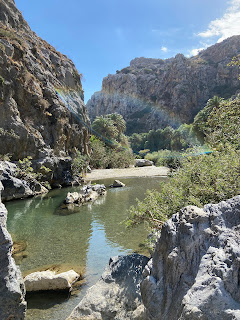


Marathi beach – We stopped at this beach on the Akrotiri peninsula to have a last look at the sea before boarding our plane back to Bergamo. The airport is nearby. We didn't swim but had a coffee and relaxed.
Sights
Palace of Knossos – The Minoan civilization began c. 3500 BC, reached a complex urban civilization around 2000 BC, and then declined from c. 1450 BC until it ended around 1100 BC. The cause of the decline is still not completely understood. The Minoan Palace of Knossos just outside of Heraklion was the political and cultural center of the civilization.
Our advice:
- Go as early as you can to avoid the crowds. For example, there is the throne room of the palace that you have to line up to see (the only place on the site you do that). At 9:00 am, we walked in without waiting. Later at 10:00 am, there were hundreds of people lined up in the hot sun to see it.
- From Eleftherias Square (here), you can catch the #2 bus to Knossos. The bus to the palace goes by a couple of schools on the way and the bus might be packed with kids.
- Get a guide. When you approach the site, the guide booth is before the ticket booth, which is confusing. After our initial confusion, we purchased a ticket and entered the Knossos site. We looked around for 10 minutes and then decided to go back out and get a guide. The guide made the experience more interesting and gave us more context to appreciate the visit.
- Without getting into the pros/cons of it, be prepared that all the interesting murals are reproductions and many parts of the iconic parts of the palace have been reconstructed, and yes we are talking about those bright red columns! Those columns would have had pine tree trunks in the middle and are wider at the top than the bottom.
- Go to the excellent Heraklion Archaeological Museum before you visit the palace. It will make the visit to the site so much more meaningful.

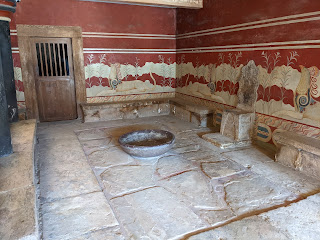


Archaeological Site of Aptera – This was an ancient city just southeast of Chania on a hill about 150 m above sea level looking down on the Souda Bay. The brochure says that Ancient Aptera was one of the most important city-states of Crete during historic times. Archaeological evidence suggests that habitation on the hill began in the 11th – 10th centuries BC. By the early Hellenistic period, the city's construction was more or less complete. During the 4th century BC, Aptera was important enough to issue its own coinage. The city enjoyed a new era of prosperity during the Roman period (69 BC – 365 AD) with the building of large public buildings. A powerful earthquake of 365 AD ushered in the slow decline of the city-state until another earthquake in the 7th century AD devastated the city.
We drove to visit Aptera on our last day in Crete before flying home in the evening.
- Set aside a good 2 or more hours to wander around and explore. The brochure you get when you buy at the ticket booth is a pretty good guide.
- Be sure to visit what's called in the brochure "Later buildings (16th century AD)", that is, the more modern buildings on the site. There is a small interpretation center (and bathrooms) inside this area with large informational boards that are worth reading through.
- A nice lunch spot before or after is the Tavern "The Aptera", which you pass by to get to the site.
Ancient City Falasarna – The city name can also be written as Phalasarna. This archaeological site is on the west coast of Crete. In ancient times, Ancient Falasarna included the promontory with the hill of the acropolis, above the city harbor. The harbor of Falasarna measured 100 m x 75 m and was the only “closed” harbor in West Crete.
The Romans weren't happy with the piracy of Falasarna and destroyed the city in 69 BC. To prevent the harbor from ever being used again, the Romans blocked the entrance with stone blocks, so that only small boats could enter. The city never overcame this disaster. Then, the great earthquake of 365 AD raised the west coast of Crete by 6-9 meters so that the harbor of Falasarna suddenly found itself on land. First the Romans than Mother Nature. Today as you walk round the archaeological site, you find the ruins of the city and its harbor are about 100 meters from the sea.
Our advice:
- A good day trip is to visit the Falasarna beaches and archaeological site. We did this as a day trip from Chania.
- The site doesn't haven't much explanation but there is an iPhone app…scan QR code when entering.
- We were recommended to watch the sunsets from Falasarna beach was a popular thing to doWe left well before sunset so didn't get to experience that.
- Don't be surprised by the number of greenhouses in the area. We read that they mostly grow tomatoes.
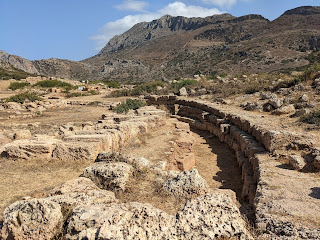
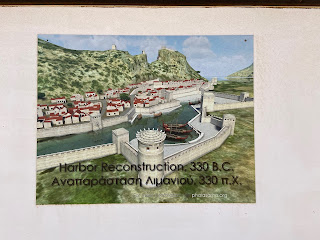
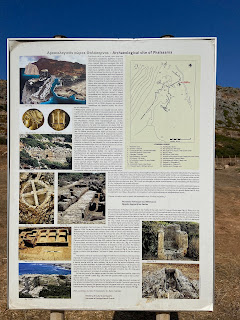
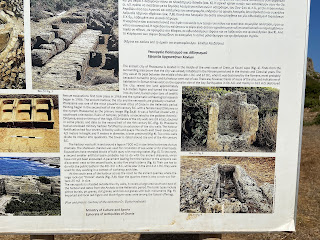
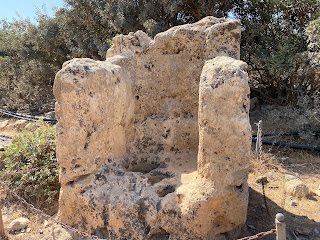
Left: The old dock of Ancient Falasarna. Left center: Reconstructed view of Ancient Falasarana. Center and center right: Informational signs at Ancient Falasarna site. Right: The throne at Ancient Falasarna.
Gouverneto Monastery and Agia Triada Tzagaroli Monastery – These two monasteries are located on the Akrotiri peninsula, about a 30 minute drive from Chania. The Gouverneto Monastery dates back to the 1500s and is a Venetian style fortress. The Agia Triada Monastery dates back to the 1600s and is more in the Byzantine style. Agia Triada is much larger and is major tourist attraction. Aiga Triada is busier because it is easier to reach, in particular by buses. Aiga Triada has a museum, a large gift shop, and wine tastings. In short, it's set up to receive a good number of tourists.
From Aiga Triada to Gouverneto the road becomes increasingly narrower but is easily driven by car. Gouverneto is smaller and has "less" to see with most people focused on doing the hike to see the ruins and the beach. The recently restored church is beautiful inside and there is a small gift shop. (We found Gouverneto to be more quaint. We talked for a while with the monk in the gift shop and that made is special.)
Our advice:
- You can make at least a ½ day trip out of visiting these two monasteries, walking, and maybe swimming.
- There's a lot to explore after "behind" (north) of the monastery. There is the Arkoudiotissa Cave (she-bear cave), empty buildings, chapels carved in rock, and the Monastery Katholiko (the one with the huge bridge over the gorge).
- To get to the trail that takes you to the Monastery Katholiko and eventually the ocean, you enter the south (pedestrian) gate of the Gouverneto Monastery property, walk along the path, and exit out the north side of the enclosed monastery property.
- Following this tail, you never enter the monastery (fortress) proper, but pass by the front door. If you do go inside the monastery proper, you may be be asked to cover up and there are garments they provide that you can put on.
- The signs at the south gate of Gouverneto monastery initially scared us into not doing the hike. They said no shorts, no swimming at Katholiko beach, and much more. We when arrived, no one was there and we only had shorts and we wanted to swim.
- Turns out that we visited inside the monastery proper and shorts were fine.
- And, we talked to a young American who said everyone swims at the beach so don't worry about it.
- To get from the Gouverneto Monastery to Monastery Katholiko, the trail is well maintained. The trail from that point onward to the ocean is a bit trickier.
- We made the trip out form Chania to visit these monasteries and on the way back we stopped at the Venizelos Tombs and had something to eat at Koukouvaya (the word means owl) with views back over the city. The tombs in question are of Greek statesmen Eleftherios Venizelos and his son Sofoklis Venizelos.
Monastery Agios Georgios, Karydi – This monastery has a complicated history involving Christians and Muslims and the coming and going of the Ottomans, like many things in Crete. The symbol of the monastery is an derelict olive oil factory with 12 arches and no roof. The mill dates back to the 1860s.
It's worth a stop and a few euros to enter. We feel especially endeared to the place because the woman collecting money and giving tickets popped into a nearby kitchen and offered us pieces of cake. It was the best chocolate cake I had in some time. Priceless!
Our advice:
- We visited this Monastery on our way into Chania from Plakias. You could make this a day visit from Chania, it's not that far.
- Eat at Maroubas in Vamos. We did and were happy.
Left: Monastery Agios Georgios, Karydi - entrance. Center left: Monastery Agios Georgios, Karydi - offered cake. Center right: Monastery Agios Georgios, Karydi - old olive oil mill without a roof. Right: Monastery Agios Georgios, Karydi - old olive oil mill.
Impressions
In some cases, we try to find out if what we observe is backed up by data. However, most of the time we just have to leave it as an impression \that might not be generalizable. Also, keep in mind, we are also dealing with an island of Greece that can have a very different feel from the mainland, as islands often do.
Crete – in general
- Smoking
in restaurants was less obnoxious than we had written
about in 2008 during a visit to Hydra and parts of the mainland. This
is because this trip we were eating outside a lot and the ban on smoking
in restaurants went into effect in 2010, after our 2008 visit.
- Water on the tables at restaurants, first thing, as a welcome. When it's hot out, that is a great touch.
- Fruit like watermelon or grapes are brought free after your meal. The fruit is often served with raki, a grappa-like drink made of twice-distilled grapes and anise. In a number of restaurants in Heraklion in particular, if there wasn't fruit offered, there was often a "house" dessert that you could get or not get for free.
- Loved the rusk, twice-baked bread as welcome touch in a dish or salad.
- Every
lunch we had seemed to be around 20 euros and it became our standing joke.
In general, the cost of eating out is less in Crete than in Italy.
- Men
and women were attractive and confident. Woman follow their own fashion
sense. In Italy, woman, especially young woman dress very similarly, in
our experience.
- A
higher percentage of the population is heavier (cf. obesity
rates by country). In Italy,
the percentage is less, and heavier people seem to be more invisible.
Larger woman we saw in Crete dress sexy and are not ashamed of their
bodies, which was refreshing.
- In two
of the three places we stayed, we found a bedding-towel kit, which includes
top sheet that you can use if you want.
- The
use of straight sheets instead of fitted sheets for the bottom sheet for
mattresses. (It took the Romans to invent the arch…see 40
Doors of Bergamo - The Ascent of Man, From Beam to Arch.)
- Toilet
paper doesn't get flushed down! It goes in a basket. It's possible to
retrain yourself after a few days .
- Toilet
seats don't stay up – at least that's what we experienced. We joked that
there must be a powerful woman's lobby in Crete.
- Parking
was generally easy. No worries about tickets or parking hassles even in
Chania where we had worry about parking our rental car.
- Driving
on the Greek
National Road 90 was orderly, with slower cars staying to the right
and letting faster cars pass. There were no speed demons or aggressive
drivers. Driving in cities was reasonable.
- Cats
rule towns and cities. There were lots of wild cats. And people feed them.
We had a few cats rubbing up against our legs at restaurants fully aware
we had some fish scraps in our dishes.
- None
to fewer church bells chiming. We are living in the land of church bells –
Bergamo Italy – so we noticed things like this.
- Be prepared for earthquakes. On the 27th there was a 5.8 centered southeast of Heraklion. At the time of the quake @ 9:17 am, we were in the water in Plakias and didn't notice anything. But the owner of the B&B where we stayed said it was felt. The next day we did feel a 5.3 quake @ 7:48 am while in Chania.
Heraklion
- Labyrinth-like
streets in city center. Fun to explore.
- Everything
close by. The city seems big but isn't. It is hilly though in some spots.
- Heraklion
is noisy city with cars and airplanes. The airport is very close to the
city and a major flight path is over the city. We stayed on a small street
that we thought would be quite but really wasn't until 2 am or so. It
could be that we just chose poorly.
- Clean
streets.
- Seems
safe. We tried to find apples to apples crime statistics, comparing Greece
with Italy but couldn't. Our feeling derives from three anecdotal
observations. First: we felt safer. Two: People walking the streets
weren't freaked out looking behind them. Three: Very few bars on windows.
Of the last observation, we see lots of barred windows in Italy and we are
told it is because of crime.
- Good
café scene on street level. But raise your eyes to the second floor and
you'll probably see dilapidated, uninhabited buildings. Sort of shabby
chic.
- Good
service in restaurants. In general, hospitality good and consistent.
- Good
restaurant choices.
- Strong
coffee culture. There are places to grab a coffee everywhere and they are typically
marketed with 'coffee' in the name. There are a few European Coffee Trip picks in
Heraklion and we tried them all and can confirm they are good.
- A fair amount of street art, and not so interesting tagging, around Heraklion.
Chania
- The main
port area can take on the look of Disneyland in the evening, at least it
felt like that for us. Thankfully, you can walk in either direction away
from the central part and find less touristy spots with a more authentic
feel.
- Parts
of town are severely run down, but not dangerous.
- Just
outside the main tourist area, you can find locals living and relaxing in
Chania. That always makes us feel good to be among people just going about
their daily business who live in a spot.
- Unfortunately,
indifferent restaurant service. (We didn't try many places but service was
less than we experienced in Heraklion.)
- Two
key museums were closed during our visit, which soured our our experience.
- Several
times we experienced a car (could have been the same one) driving with a
old-style speaker on the roof blasting announcements.
- Kids
wander the street at the start and end of school day, with not a care in
the world or to traffic. You really have to pay attention if you are
driving
- Double
parking everywhere. It slows traffic but nobody seems to mind.
- No
signaling when driving.
- Strong
coffee culture like Heraklion. Again, European Coffee Trip to the
rescue.
- Some
street art, but not as "nice" as Heraklion.
Photo Essays
Botanical
Left to right: Ceratonia siliqua leaves and flower. Drimia maritima. Heliotropium europaeum. Pancratium maritimum. Phoenix theophrasti. Ricinus communis.






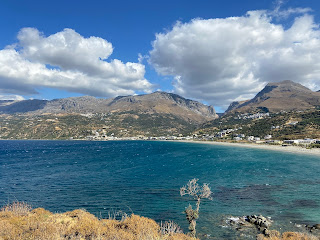

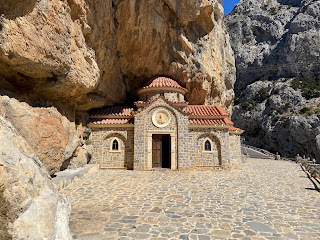





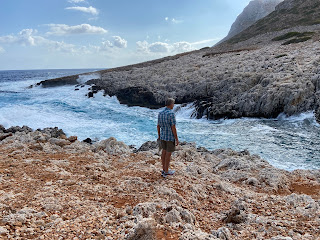

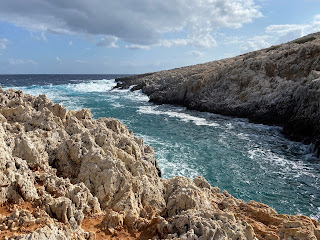





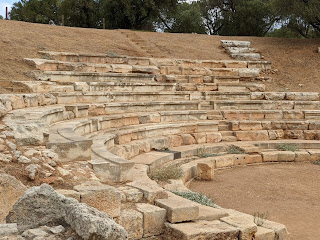
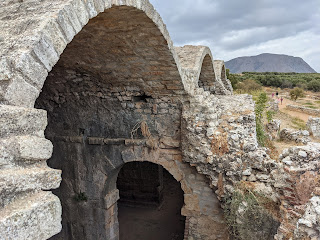



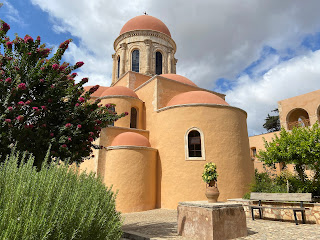










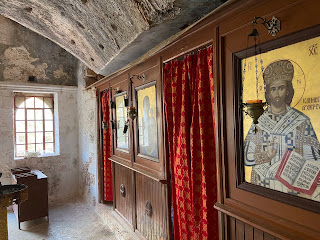













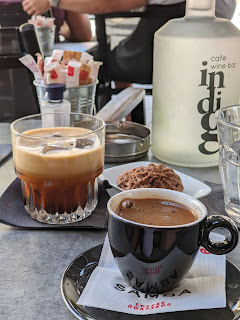





















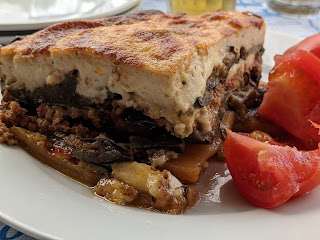





































No comments:
Post a Comment
All comments are moderated. If your comment doesn't appear right away, it was likely accepted. Check back in a day if you asked a question.